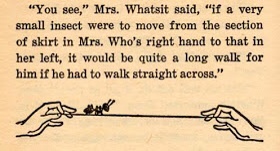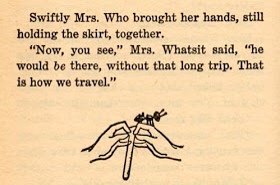Welcome to 2013! A year with an ominous number and endless possibilities! It's also one year closer to 2015, my stated goal year for 1:1 technology programs in all schools. As I look forward to this goal, I can't help but think of a comic from many years ago in which two professors stare at a board covered with a complex equation. The senior professor remarks that he has a question about the middle step where it is written THEN A MIRACLE HAPPENS. I know where we are today; I know where I want to be. The middle steps are still very blurry in my mind.
First among these “miracles” is faculty instruction and formation. In order to justify the cost of these devices as well as demonstrate their value, students must use their devices regularly for real purposes. Electronic textbooks will go a long way in this area. A good e-text should be self-explanatory and should provide established value at a competitive price. There are few effective arguments for staying with paper texts if an electronic reader is available. However, if electronic texts are the only use of the student machines, the value is greatly limited. This is a clear case of new wine into old wineskins, new technology used to perpetuate an old model.
No, if 1:1 is to be transformative, rather than iterative, it has to be part of a blended learning model. Blended Learning is a term describing a classroom or school where learning takes place using a combination of instruction strategies, including the use of technology. Though I'm not the largest fan of on-line courses (probably because I was never good at them) a technology based system can supplement other types of classroom instruction and provide adaptive, leveled instruction in ways that a single teacher never could. Students need to work with a teacher, with other students, and with a computer, all during the course of a school day.
However, in order to have an effective blended learning environment, we need teachers to guide it. How we give our current labor force the ability (not to mention the drive) to develop and present lessons using technology has been our mission and, to a great extent, our failure through the past decade. Imagining a time when the majority of teachers prepare live, collaborative, and on-line content is like dreaming of snow in the Bahamas.
But I'm tired of waiting, and our students can't wait any longer.
Maybe the problem is me (usually is); maybe I and other tech instructors have been approaching it the wrong way. For me, technology use is a function of a fully-integrated understanding and immersion in digital tools and options. To some extent, much professional development has been trying to create the same awareness and orientation in teachers. We've been teaching them how to build a radio, when all they want to do is play the radio.
One of the most formative books of my childhood was Madeline L'Engle's A Wrinkle in Time. When I was thinking about this topic earlier, I pictured two illustrations from my 1960’s edition of the book. A quick Google search found them. I'm not certain about the legality of using these images, but I'll cite and hope for the best.
The images were used to illustrate travel by using the concept of the Tesseract, a way of compacting space as is seen below:
To move to an effective, widespread blended classroom model, we will need content providers to create products that comprehensively address the need for direct leveled student instruction and assessment. We can't wait for teachers to develop the tools for those students who are working at computers, nor can we rely on(or expect most teachers to understand) a kluge of free and unrelated apps and resources. There are many excellent teachers who can create this environment, but there are far more excellent teachers who cannot and will not. However, all teachers can be taught to guide students in the use of a well-developed program. We have to stop trying to urge the ant across the divide and put our fingers together to be there now!
The world of education business is a testing-obsessed culture. The amount of resources and money poured by publishers into the creation of the “perfect” standardized exams is wildly disproportionate to their educational value. Might I suggest that some of these resources be rerouted into the creation of integrated levelled instruction systems that can be used as part of a blended instructional program? My teachers do not have the ability or time to do this effectively. I don't have the time to do this effectively. Why, when I ask publishers for something like this, am I greeted with blank stares? I can describe exactly what we need…someone come and ask me!
I'm certain there will be some reaction that a structure like this would kill teacher creativity and create robot classrooms. I would argue quite the opposite. I am a strong proponent for the teacher led classroom, with teachers curating the tools that they are given, but I don't ask teachers to whittle their own quills or write their own textbooks (ignoring for the moment the arguments against traditional textbooks). Using technology to assist in student learning, particularly if the products (deliberately avoiding the overused apps) use proven methods of instruction, assessment, and reporting, can be a vital tool and essential component in a 21st century classroom.
21st century? We are THIRTEEN YEARS in already…it's time for us to stop seeing the goal from afar and to get there…now!
As always, I welcome your comments.
Image Credits:
- Tesseract. http://www.flickr.com/photos/kowalskirsflickr/3158702666/in/photostream/. Cc
- A Wrinkle in Time by Madeleine D'Engle, Scholastic, 1962



Excellent post! But where can we find a Tesseract to get us to where we need to be? Seriously, I do wonder why the publishers, etc. have not yet shown us something along these lines. Surely there has to be some serious money somewhere invested in creating such learning management systems? Will they be part of the next generation of student information systems?
Great blog, Greg.
Two thoughts come to mind…. 1. Doug Lemov’s work, in particular one technique he calls “Shortest Path”. In sum, the shortest path is the distance between stating a given objective and each student mastering that objective. As you state, teachers are the curators of tools. Technology is one tool: as an instructional strategy,to determine student grouping, and as a learning material to be considered for achieving the stated objective. 2. Teachers need time to explore technology tools and applications. I think they need time with various tools: iPads, interactive white boards, etc. and applications, as well as, really cool teaching and learning websites.
In closing and with regard to “A Wrinkle in Time”(I used to teach that novel!), I think the end of the string represents your 1:1 vision while the beginning represents an assessment of where teachers AND principals are at…followed by meeting them where they are at and working toward the vision. I wish the process were as simple as bringing the two points of the string together, however it is not. The fun stuff is what happens in the middle…the joy (and pain, a.k.a. struggle/chaos) of learning experienced by teachers that leads to implementation and new ways of learning for students. Even more fun stuff involves the involvement of students in determining the role of technology; students are excited to be guinea pigs and even partner with teachers and leaders to discern the use and value of tech tools and applications in their learning.
Nice post – I agree with Susan that the journey is part of the fun (and struggle and frustration) so setting the vision and goal is step one…THE MIRACLE HAPPENS is where the uncertainty lies but where the satisfaction of accomplishment is experienced.
But it is also the challenge. I find that the biggest impediment to technology implementation is the fear that ‘something better is right around the corner’. This leads to a type of paralysis where principals don’t do anything because something better will be available any time. The key PD strategy needs to center on goals and what specific outcomes the teachers want to see with students. As you state, then the tool to achieve those outcomes can be implemented.
The other factor we have discussed in the past is that the device will become less relevant as the cloud grows in influence. So multiple platforms can be used in the same classroom to access the same content. So the device paralysis may not exist when it doesn’t matter what device you use but rather what software and content you use.
Great post. Part of the challenge is getting over the fear and being ready and knowledgable on how others are using 1:1 and realizing the value for the students. Barbara Levin and Lynn Schrum have written two excellent books on Leading 21st Century Schools and Leading Technology Rich Schools that offer case studies for 1:1 and resources for using technology in the classroom. Just reading these has given me the background to hit the ground running when our school makes the move.